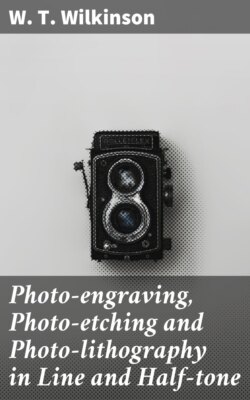Читать книгу Photo-engraving, Photo-etching and Photo-lithography in Line and Half-tone - W. T. Wilkinson - Страница 16
На сайте Литреса книга снята с продажи.
STRIPPING COLLODION FILMS.
ОглавлениеNegatives made by the wet collodion process can be easily stripped from the glass support, and in such a condition are extremely handy, especially for printing on collographic plates, or on zinc or copper, as, the film being flexible, contact is more easily secured.
When it is intended to strip the film, the glass plate must be polished, not albumenized, and after the negative is dried, strips of thick paper are pasted along the four sides of the negative, with starch, or a solution of gum tragacanth; the negative is then placed on a levelling stand and a sufficient quantity of the following warm solution of gelatine is poured upon the plate (which should be slightly warmed first) and spread all over it by means of a glass rod:
| Gelatine | 2 1⁄2 | ounces. |
| Sugar | 1 1⁄2 | ounces. |
| Water | 20 | ounces. |
Soak the gelatine in the water until soft, melt by gentle heat, then strain through two or three thicknesses of fine muslin, and pour upon the plate, using three ounces for a plate 12 × 10; more or less, in proportion for different sizes. The plate must be allowed to stay upon the levelling stand until the gelatine has quite set, then put it on a rack to dry, in a current of cold air, for if heat be used the gelatine will melt.
When the gelatine is quite dry, pass the blade of a penknife all around underneath the strips of thick paper, when the negative film may be lifted away from the plate.
In this condition the negative may be stored away without risk of being broken, the only condition being, it must be kept free from dampness. {35}
Another plan of stripping is to coat the dry negative with a thick solution of India-rubber in benzole, and allow it to dry on a levelling stand; then coat with a thick plain collodion, to which a few drops of castor oil have been added. When the collodion film is quite dry, place the plate in a dish of clean water, strip off the film from the glass, then place the film between sheets of clean blotting-paper to dry, or it may be allowed to dry on the plate.
Old collodion negatives that have been varnished may be stripped, but it is rather a risky operation, and should never be attempted until a really good carbon transparency has first been obtained.
The first step will be to remove the varnish, which is effected by soaking the plate in
| Alcohol | 1 | part. |
| Ammonia | 1 | drachm. |
until all the varnish is removed, then rinse in alcohol, wash well under the tap, dry, paste slips of brown paper around the margin, and finally level and cover with the warm gelatine, dry and strip.
